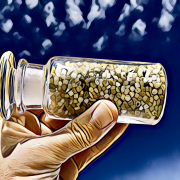
If you’ve been a citizen scientist for Nurdle Patrol, you’re probably familiar with the collection process: going out to your local shores, picking up plastic pellets from the waterline, and logging the data. But you may have wondered, what’s next? Clearly, you wouldn’t just fling them out into the ocean again. So, what do you do with these newly collected nurdles to make sure they don’t end up polluting a different beach?
Jace Tunnell, reserve director at the University of Texas Marine Science Institute, gets this question all the time. His suggestion is to “put the nurdles in a cool jar so [you] can show other folks and spread the word.” Putting nurdles on display is a great way to raise awareness for Nurdle Patrol and the nurdle pollution problem. Alternatives could be to send your nurdles to nurdle artists who make sculptures and jewelry to bring light to the issue, or you could make your own art! Keep in mind that nurdles absorb harmful chemicals, such as PCBs and PAHs, so wash your hands after handling nurdles and keep them away from young children or animals that might consume them. If you take this creative route, maybe you’ll be able to bring others’ attention to nurdle pollution and encourage them to look for nurdles with you.
If you would rather throw your nurdles away, you should know that disposing of nurdles is not as easy as tossing them in the recycling bin. Nurdles can be lost to waterways, even in the recycling process, due to their small size. In addition, they are often made up of different plastics that would have to be sorted in recycling plants, but often can’t be when they are in the form of pre-production pellets. You can read more about different plastics in nurdles, as well as how to differentiate nurdles from similar plastic objects in our article Yes Nurdle, No Nurdle. If you want to throw them away, the best course of action would be to put them in a closed container or bag before throwing them in a garbage can or recycling bin. This way, you’ll ensure that your collected nurdles won’t end up polluting the environment again. Stay safe, and happy nurdling!
-----------------------------------------------------------------------------------
What is a nurdle? It's a lentil size piece of plastic that is the raw material to almost everything made of plastic. Once these nurdles are made, they are shipped all over the world to make every day plastic products. The nurdles are escaping to the environment at the manufacturing facility when loading/unloading to rail-car or trucks, fall out during transportation, and during spills at sea and on land. The biggest impact is to fish and wildlife that eat the nurdles since they look like a natural food source. Fish, birds, and sea turtles have all been documented as eating these plastics. The nurdles also absorb harmful chemicals such as PCBs and PAHs that are known to impact animals negatively. Nurdle Patrol is trying to find the source of the pellets by counting concentrations on our beaches, bay shorelines, and rivers. Check out the map at www.nurdlepatrol.org to see what data has been collected in your area, and where data still needs to be gathered. Come join us, use your phone, and pick up plastic pellets at your favorite beach!
About the author: Arya Das is a high school student from the San Francisco Bay Area. She is currently a junior, and plans to major in environmental engineering and work in pollution prevention or renewable energy after college. Arya works with reserve director Jace Tunnell to write articles for the citizen science project Nurdle Patrol.


